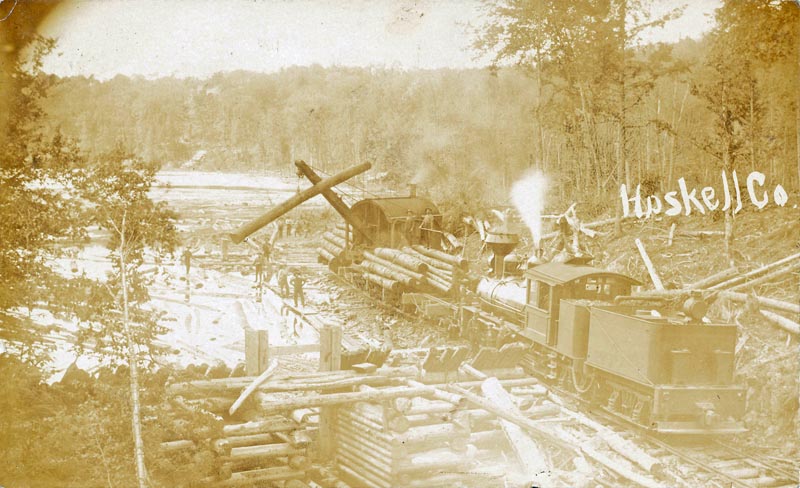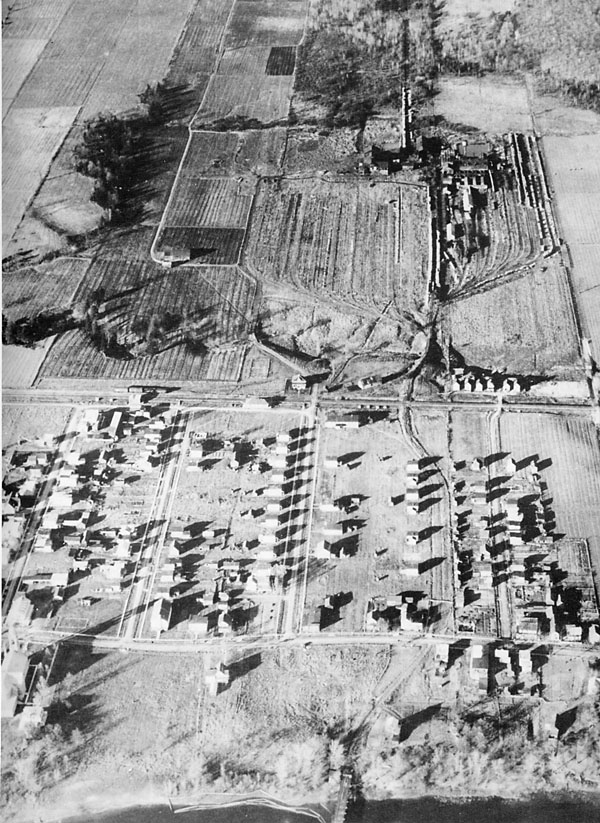|
The Salmon River and
Northern Railway
 This image, from a postcard, was provided by Doug Aikenhead of Ann Arbour, Michigan. It shows one of the three-truck Shays, 53 or 54, working in the woods. The small village of Fassett, Quebec, just
east of Montebello, was a very busy place at one time. In 1906 the
Haskell Lumber Company decided to construct a mill there to cut the
wood which was available in the Laurentian Hills, to the north of the
Ottawa River. One of the Directors of the Company was a Mr. J.W.
Fassett who gave his name to the village. F.H. Hopkins, the contractor,
carried out much of the work using a small Davenport 0-4-0 saddle tank
steam engine. The mill commenced operation in 1907 and a
standard gauge line was built from a dock on the Ottawa River, across
the Canadian Pacific North Shore line (Lachute Subdivision) and for
some 27 miles north and west towards Mont Laurier. The line was
constructed with 75 pounds per yard rail and closely followed the
contours of the land, curving along the banks of the Salmon (now
Riviere Kinonge) and West Branch (now Riviere Kinonge Quest) streams in
a very picturesque location.
Three, Shay-type, geared locomotives were purchased new to work the line. The first was No. 51, a two-truck Shay. The other two, Nos. 53 and 54, were three-truck versions. The Davenport, which was used around the mill yard, took the number 52. Around this time, Haskell Lumber became Fassett Lumber but the locomotives retained the same numbers. Lumber was cut at the mill for shipment by rail and water on the Ottawa River. Bark was also shipped out for U.S. tanneries. The line also provided 50" hardwood cordwood for the Standard Chemical Company's distillation plant at Fassett and a separate locomotive was allocated to this work. The small Davenport was not up to the job and it was scrapped in 1910. It was replaced by a brand new 0-4-0 saddle tank locomotive from Montreal Locomotive Works. This was purchased by Standard Chemicals, becoming Number 4. The situation remained relatively stable through the First World War and into the post war boom of the 1920's. The Company used 36-foot long log cars together with flat cars rented from the CPR. Snow was heavy and the company snow plow was used frequently in winter. There were problems with ice build up on the many bridges on the line. At one time over 100 men were at work picking the ice. They even used a home made ice breaker. The worse grade on the line was a quarter mile of 9% at High Bridge on the way up. There were many stretches at 4% and some up to 7%. The only bad stretch on the loaded journey was a mile long section at 7% which was just two miles from the Fassett mill. The trains either had to double this section or whistle for another locomotive to come out from the mill to assist. The last section into the mill yard was on a steep descending grade. All hand brakes had to be tied down to assist the air brakes to hold back the train. By the end of the 1920's the cut was reduced and the Fassett Lumber Company decided to move to Foss Mill, Ontario, in Algonquin Park. Standard Chemicals took over the Salmon River and Northern Railway in order to maintain its supply of hardwood. Shay No. 53 was sold to Standard Chemicals while the other two Shays, Nos. 51 and 54, moved to Foss Mill where they worked on a logging line to Tea Lake. The saddle tank, No. 4, remained at Fassett to switch the yard. It was soon found that one main line locomotive was insufficient and another geared locomotive, this time a Climax no less, was sent from the Standard Chemical Company's plant at South River, Ontario, to help out. This locomotive had come new to South River and retained the number 200 which it carried there. Between 1929 and 1931 No. 53 was leased to the Thurso and Nation Valley Railway which was under construction at that time. The railway was becoming increasingly costly to maintain and the cutting rights expired in 1937 (they reverted to the Seignery Club). The rails were torn up in 1938 and sold for scrap. No. 53 was cut up at Fassett the same year. The MLW saddle tank No. 4 was used in the yard until 1940 when it was replaced by another small 0-4-0 saddle tank which came from the company's Longford, Ontario, plant. What happened to the two Shays that went to Foss Mill? Sometime during the late 1930's the operation was reorganised as the Staniforth Lumber Company. The railway was abandoned when the operation was moved to Kiosk which had no railway. No. 51 burned in the roundhouse at Foss Mill but No. 54 was purchased by Zagerman's (an Ottawa scrap dealer) and was for sale at Barry's Bay in 1942. Although details on its final disposition are unclear, it was probably scrapped as part of the war effort. Interestingly, when the T&NVR was looking to extend its line in the early 1940's, the company looked at the supplies that were stored at Barry's Bay. They were not suitable as the T&NVR did not use stub switches! Salmon River and Northern Railway
Locomotive Roster
 Aerial view of Fassett, Quebec,
looking north from over the Ottawa River on October 30, 1927. CPR's
Lachute Sub. runs
from right to left. The Fassett station, with two boxcars and two
loaded gondolas
in the siding, can be seen clearly. The Fassett Mill is in the centre
with
two rail yards running north/south. This photo was probably taken after
the
lumber operation had moved to Foss Mill, Ontario, as the western yard
has
been lifted. The yard throat extends into the interchange track with
the
CPR. The CPR diamond and the line to the dock on the Ottawa have also
been
lifted but can be clearly seen. There are several piles of logs close
to
the tracks in the yard. The main line runs north and then veers north
west
as it climbs out of the Ottawa River valley. There is a wye to the west
of
the main line. This is set in the trees to the north of the mill and
cannot be seen from this angle.
"This aerial photograph, No. HA523-52, copyright 1927, Her Majesty the Queen in Right of Canada, reproduced from the collection of the National Air Photo Library with permission of Energy, Mines and Resources Canada." 
Bytown
Railway Society, Branchline, May 1988
|